For the month of June, the BFL is honored to host a multisensory exhibit entitled Native American Reflections – We Are Still Here. Come to the library to enjoy paintings, poetry, baskets, and other works of art created by members of Natick Nipmuc Tribe, Abenaki Nation, Algonquin Nation, Inuk Nation, and Wampanoag Nation.

The featured Natick Nipmuc artists are profiled here
Maria Turner
Maria is the chairwoman and genealogist for the Natick Nipmuc. 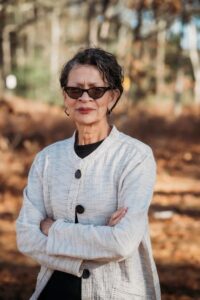 She lives in Mashpee and works as the Indian Child Welfare Act (ICWA) Director for the Mashpee Wampanoag Tribe. She holds a Masters of Education in Counseling from Bridgewater State University.
She lives in Mashpee and works as the Indian Child Welfare Act (ICWA) Director for the Mashpee Wampanoag Tribe. She holds a Masters of Education in Counseling from Bridgewater State University.
In 2019, Maria retired as a supervisor for the Massachusetts Department of Children and Families (DCF), where she worked just shy of 25 years. In her career, she also worked as the school wellness counselor for the Wopanaak Language Reclamation Project (WLRP), a middle school teacher, a social service advocate, and the director of safe housing for teen girl runaways. She also spent a decade running a camp in Mashpee for children aged 5-14 who could not otherwise afford to attend camp. Maria co-Authored the DCF booklet Me Naturally: How to care for my Hair and Skin, a guide for children of color in foster care.
Maria’s leadership experience and affiliations consist of being a Representative of the American Baptist Church (ABC) Indian Ministries Eastern Region, Mashpee Indian Education Parent Committee Chair, The Massachusetts DCF Racial, Ethnic and Linguistic Minority Affairs (RELMA) Chair, Cape & Islands Guidance Association (CIGA), and Massachusetts School Counselors Association.
Rachel Healing Willow Bayliss
featured art work: Winged Foot and No More Stolen Sisters
 Rachel’s art, in her own words:
Rachel’s art, in her own words:
Wunne Nogkishkoadtuonk! (This means “Greetings” in the L – dialect of the Algonquin language. This is the dialect most frequently used by the Eastern Woodland Indian tribes.)
My birth name is Rachel Curtis Bayliss, and I was born in Framingham and grew up in Medway. My native name is Healing Willow. I am a member of the Natick Nipmuc Indian Tribe and I also hold a seat on the Tribal Council as secretary. I am a wife and mother of 2 boys and 1 dog.
When I read about the Winged Foot project to be featured during the Boston Marathon, I felt an inner calling to design a piece representing my indigenous heritage to be put on display for all the world to see. I wanted to remind all people watching that this event is being held on Native land and WE ARE STILL HERE! The top portion on my Winged Foot is a tribute to all of the missing and murdered indigenous women of North America. The red hand print symbolizes all those whose voices have not been heard and may never be again. I take it upon myself to speak up for the souls we have lost, and keep my heart and mind open so that I may be a vessel for their stories and struggles to pass through. I encourage you to research this cause. #MMIW
The remaining portion of my Winged Foot is in honor of my tribe, the Natick Nipmucs. The fire represents our sacred traditions. In addition to the fire being the center of our ceremonies and circles, its versatile nature gives us a great many things like warmth and a place to cook what our hunters have gathered for nourishment and strength. The smoke from the fire also provides a pathway to Manitoo and our ancestors to hear our prayers. The writing on the Winged Foot “We Are Still Here” is the message I would like to send to our ancestors as they watch over us on this day and always. The eastern woodland animal tracks at the bottom stands for the 5 named clans’ of the Natick Nipmuc tribe: Eagle, Deer, Turtle, Hawk, and Bear.
I created No More Stolen Sisters to call attention to the Indigenous women that have gone missing and murdered in their homeland. I choose to be the voice for those whose voices have been senselessly taken from them.
Aquene kah Nahonnushagk! (Peace and Farewell!)
Kuttabotomish! (I thank you!)
Tony Curtis Hall
featured art work: Night Flower, Copper Bracelets, Flat Sun
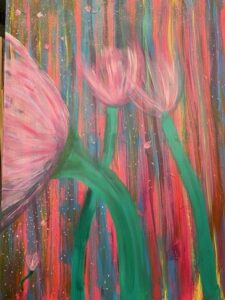


Shani Turner
featured art work: Corn Husk Dolls

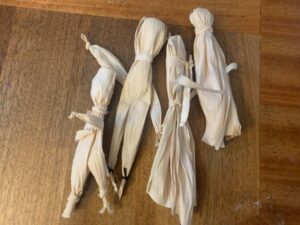
Shani Turner is an Indigenous artisan. She attended Oakland University in Rochester, Michigan, and was a prior Indian Education Coordinator for the Mashpee Public School District.
Shani is the Natick Nipmuc Tribe’s Medicine Woman and specializes in Dance Forms and Artifacts. She has performed many storytelling playwrights for state-wide public school districts, and was the lead actress of the Ashuwonk play for Plimoth Patuxet. Shani also teaches the making of Corn Husk Dolls.
Elliot “Whispering Beaver” Simmons-Uvin
featured art work: Years of Service, Tonquin Salmon
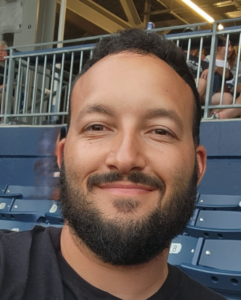 Elliot “Whispering Beaver” Simmons-Uvin is a member of Natick Nipmuc Tribe and currently
Elliot “Whispering Beaver” Simmons-Uvin is a member of Natick Nipmuc Tribe and currently 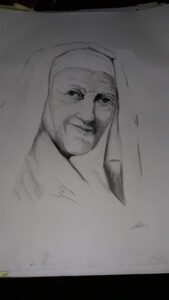 resides in Worcester. His childhood years were spent exploring the seasons of Franklin Park in Roxbury, and the coastline of Cape Cod and Martha’s Vineyard.
resides in Worcester. His childhood years were spent exploring the seasons of Franklin Park in Roxbury, and the coastline of Cape Cod and Martha’s Vineyard.
Post college, the artist spent two years in volunteer service, which inspired Years of Service, living in solidarity with the RA’s and seeing their service to others and within the self. After returning to the states, he reintegrated/engaged with his tribe, where he relearned the cultural traditions and ceremony.
Elliot’s second piece, Tonquin Salmon, was a commissioned mural by a friend of the artist.
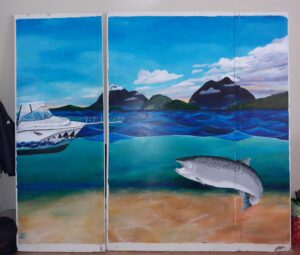
Previous Art Exhibits
June 4th – June 26th: Native American Reflections – We Are Still Here
May 21st – June 3rd: Babsje
March 28th – May 14th: Rebecca McGee Tuck
February 8th – March 27th: Carol Keefe and Bobby Reeve
December 15th – February 7th: Ryan Black
Page header image by Jan Mateboer from Pixabay


